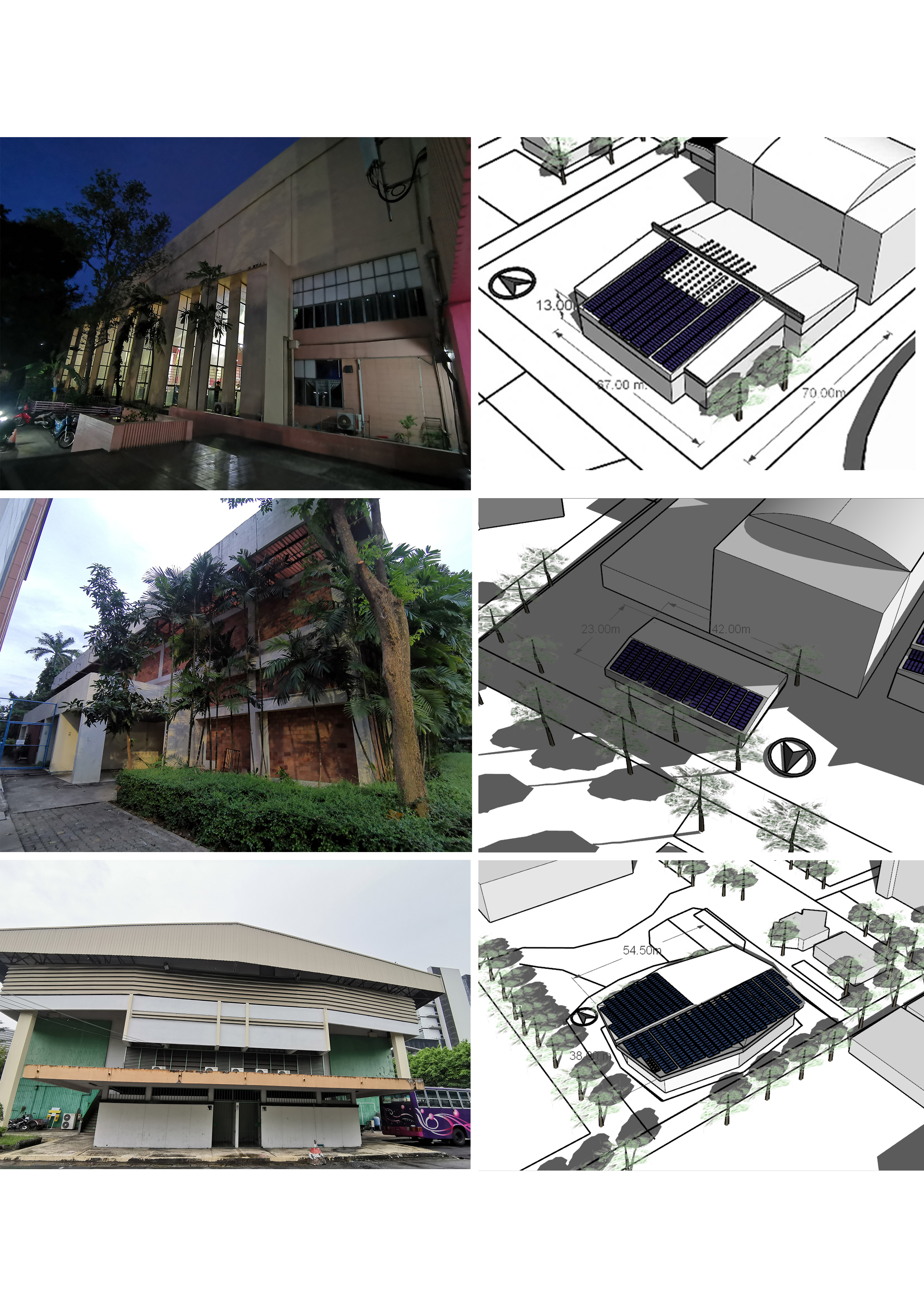Feasibility assessment of solar rooftop systems for gymnasium: case study of Chulalongkorn University
Main Article Content
Abstract
Chulalongkorn University is a large educational institution that has various kinds of activities, in which the cost of electricity usage is increasing almost 17% in 2018. High electricity bill has become one of the serious issues of the university. Photovoltaic system is one of the productive ways for solving this problem. The objective of this study is to
assessment and to compare the quality of solar rooftop system using in the gymnasium daily. This study leads to an analysis and suggestion for solar cell installation which can be enough for usage and battery backup. Cases of the study included three gymnasiums in Chulalongkorn University and the data was collected in the form of architecture survey, survey of electricity usage of each building, and schedule of building usage. The program of System Advisor Model Version 2018.11.11 was applied to calculate the electricity energy.
Feasibility assessment of solar rooftop systems for three gymnasiums include Indoor Stadium 1 in daytime and night time (without air conditioner), Chanthanayingyong Gymnasium in daytime and night time (with air conditioner) and Indoor Stadium 2 in night time (without air conditioner). The result revealed that photovoltaic system can produce electricity sufficiently during daytime and can reach almost 62%, 47% and 8% of daily electronic energy use. This study concludes that the building that is used in daytime and night time without air conditioner and battery backup is suitable for the investment because the cost of installation is 2-3 times as expensive as regular system. Moreover, solar rooftop system can decrease the electricity bill. The photovoltaic system can produce 336,579 KWh/year. This system can produce electricity sufficiently during daytime. It can reach almost 62% of daily electronic energy use, performance ratio is ranged in 68% and IRR 13%. The payback period is 7 years.
Article Details
References
Billir, L. & Yildirim, N. (2017). Photovoltaic system assessment for a school building. International Journal of Hydrogen Energy, 42 (28), 17856-17868.
Chaiyakul, Y. (2018). Karn prubprung rabob saengsawang sun ahan lae borikan 1 Mahawitthayalai Khon Kaen. (In Thai) [Lighting improvement for food and service complex I, Khon Kaen University]. Built Environment Inquiry Journal, 17 (1), 163-182.
DD Best Co., Ltd. (2019). Battery price for solar rooftop. Retrieved October 22, 2019, from http://www.solarproduct.solar
Energy Research Institute, Chulalongkorn University. (2017). Rai ngan chabap sombun khong karn pramoen sakkayaphap karn phalit faifa chak phalangngan saeng athit baep tittang bon langkha nai Chulalongkon Mahawitthayalai. (In Thai) [Final report potential assessment of solar rooftop systems: case study of Chulalongkorn University]. Bangkok: Author.
Minister of Energy. (2016). Phaen phatthana phalangngan thotthaen lae phalangngan thang lueak pho so 2558-2579 (AEDP2015). (In Thai) [Alternative energy development plan 2015-2036]. Retrieved September 8, 2019, from http://www.eppo.go.th/index.php/th/plan-policy/tieb/aedp
Mukisa, N., Zamora, R. & Lie, T. (2019). Feasibility assessment of grid-tied rooftop solar photovoltaic systems for industrial sector application in Uganda. Sustainable Energy Technologies and Assessments, 32, 83-91.
National Renewable Energy Laboratory. (2018). System Advisor Model Version 2018.11.11 (SAM). Retrieved September 7, 2019, from https://sam.nrel.gov/
Nyangon, J. (2019). Feasibility study of city scale solar power plants using public buildings: case studies of Newark and Wilmington Delaware with early investigations of Bifacial solar modules and dual orientation racking as tools for city-scale solar development. Newark : University of Delaware.
Office of Physical Resources Management, Chulalongkorn University. (2018). Electricity bill Chulalongkorn University. Retrieved October 8, 2019, from http://www.electrical-prm.com/EReport111.htm
Piriyasatta, P. (2016). Karn chai sel saeng athit bon langkha arkhan khana Sathapattayakamsat Mahawitthayalai Khon Kaen phuea karn prayat phalangngan. (In Thai) [Using photovoltaic system on the Faculty of Architecture’s building rooftop in Khon Kaen University for energy conservation]. Academic Journal: Faculty of Architecture, Khon Kaen University, 15 (1), 183-200.
Suwanasang, N. (2014). Karn pramoen sakkayaphap choeng theknik lae setthasat khong rabop phalit faifa phalangngan saeng athit bon langkha arkhan nai Chulalongkon Mahawitthayalai. (In Thai) [An assessment of the technical and economic potential of rooftop solar systems on Chulalongkorn University’s buildings] (Master’s thesis). Bangkok: Chulalongkorn University.
Tantisattayakul, T., Rassameethammachote, P. & Auisakul, M. (2017). Karn pramoen phonprayot thang phalangngan singwaetlom lae setthasat samrap rabop phalit faifa phalangngan saeng athit bon langkha arkhan phainai Mahawitthayalai Thammasat Sun Rang Sit. (In Thai) [Energy, environmental and economic assessment of solar rooftop systems on buildings of Thammasat University, Rangsit Centre]. Thai Science and Technology Journal, 25 (6), 1083-1099.
The Association of Siamese Architects under the Royal Patronage. (2015). Karn okbaep rabop phalit faifa phalangngan saeng athit samrab arkhan nai prathet Thai. (In Thai) [Photovoltaic system design guidelines for buildings in Thailand]. Bangkok: Plus Press.
Yimprayoon, C. (2016). Botkhwam parithat: arkhan chai phalangngan pen sun. (In Thai) [Review article: zero energy building]. Journal of Architectural/Planning Research and Studies, 13 (2), 1-30.


